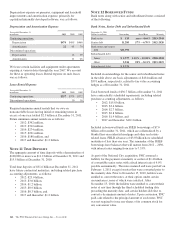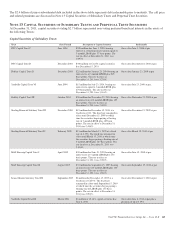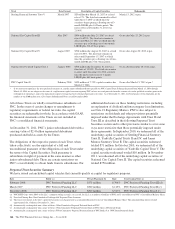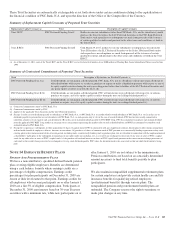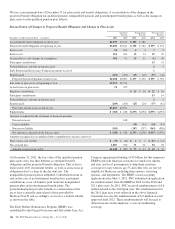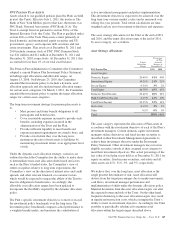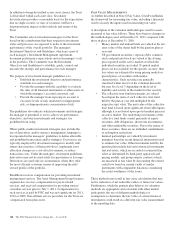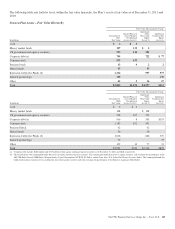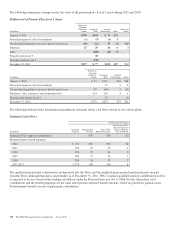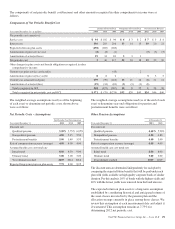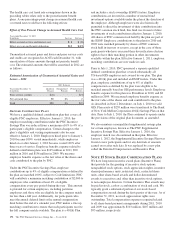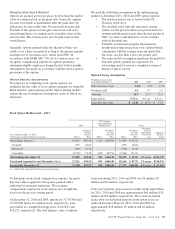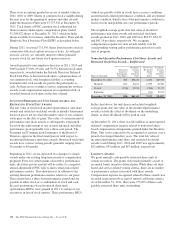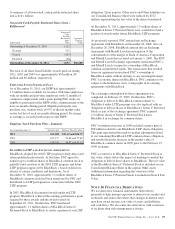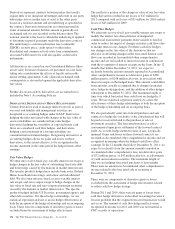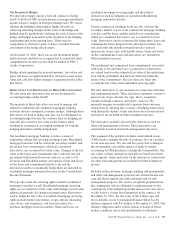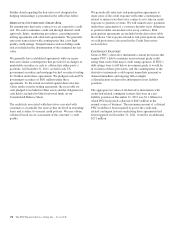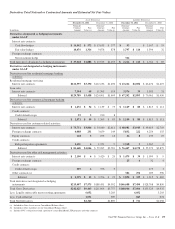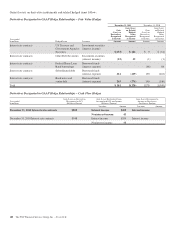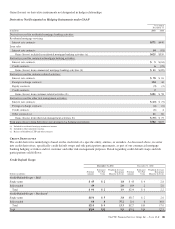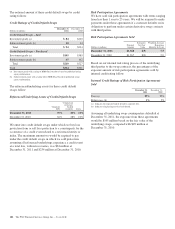PNC Bank 2011 Annual Report Download - page 181
Download and view the complete annual report
Please find page 181 of the 2011 PNC Bank annual report below. You can navigate through the pages in the report by either clicking on the pages listed below, or by using the keyword search tool below to find specific information within the annual report.
The health care cost trend rate assumptions shown in the
preceding tables relate only to the postretirement benefit
plans. A one-percentage-point change in assumed health care
cost trend rates would have the following effects:
Effect of One Percent Change in Assumed Health Care Cost
Year ended December 31, 2011
In millions Increase Decrease
Effect on total service and interest cost $1 $(1)
Effect on year-end benefit obligation $13 $(13)
Unamortized actuarial gains and losses and prior service costs
and credits are recognized in AOCI each December 31, with
amortization of these amounts through net periodic benefit
cost. The estimated amounts that will be amortized in 2012 are
as follows:
Estimated Amortization of Unamortized Actuarial Gains and
Losses – 2012
2012 Estimate
Year ended December 31
In millions
Qualified
Pension
Nonqualified
Pension
Postretirement
Benefits
Prior service (credit) $ (8) $(3)
Net actuarial loss 88 $6 2
Total $80 $6 $(1)
D
EFINED
C
ONTRIBUTION
P
LANS
We have a qualified defined contribution plan that covers all
eligible PNC employees. Effective January 1, 2010, the
employer matching contribution under the PNC Incentive
Savings Plan was reduced from a maximum of 6% to 4% of a
participant’s eligible compensation. Certain changes to the
plan’s eligibility and vesting requirements also became
effective January 1, 2010. Employees hired prior to January 1,
2010 became 100% vested immediately, while employees
hired on or after January 1, 2010 become vested 100% after
three years of service. Employee benefits expense related to
defined contribution plans was $105 million in 2011, $90
million in 2010 and $136 million in 2009. We measure
employee benefits expense as the fair value of the shares and
cash contributed to the plan by PNC.
Under the PNC Incentive Savings Plan, employee
contributions up to 4% of eligible compensation as defined by
the plan are matched 100%, subject to Code limitations. PNC
will contribute a minimum matching contribution of $2,000 to
employees who contribute at least 4% of eligible
compensation every pay period during the year . This amount
is prorated for certain employees, including part-time
employees and those who are eligible for the company match
for less than a full year. Additionally, for participants who
meet the annual deferral limit or the annual compensation
limit before the end of a calendar year, PNC makes a true-up
matching contribution to ensure that such participants receive
the full company match available. The plan is a 401(k) Plan
and includes a stock ownership (ESOP) feature. Employee
contributions are invested in a number of mutual fund
investment options available under the plan at the direction of
the employee. Although employees were also historically
permitted to direct the investment of their contributions into
the PNC common stock fund, this fund was frozen to future
investments of such contributions effective January 1, 2010.
All shares of PNC common stock held by the plan are part of
the ESOP. Employee contributions to the plan for 2010 and
2009 were matched primarily by shares of PNC common
stock held in treasury or reserve, except in the case of those
participants who have exercised their diversification election
rights to have their matching portion in other investments
available within the plan. Effective January 1, 2011, employer
matching contributions are now made in cash.
Prior to July 1, 2010, PNC sponsored a separate qualified
defined contribution plan that covered substantially all
US-based GIS employees not covered by our plan. The plan
was a 401(k) plan and included an ESOP feature. Under this
plan, employee contributions of up to 6% of eligible
compensation as defined by the plan were eligible to be
matched annually based on GIS performance levels. Employee
benefits expense for this plan was $6 million in 2010, and $8
million in 2009. We measured employee benefits expense as
the fair value of the shares and cash contributed to the plan.
As described in Note 2 Divestiture, on July 1, 2010 we sold
GIS. Plan assets of $239 million were transferred to The Bank
of New York Mellon Corporation 401(k) Savings Plan on that
date. Prior to July 1, 2010, the Plan continued to operate under
the provisions of the original plan document, as amended.
We also maintain a nonqualified supplemental savings plan
for certain employees, known as The PNC Supplemental
Incentive Savings Plan. Effective January 1, 2010, the
employer match was discontinued in that plan. Effective
January 1, 2012, the Supplemental Incentive Savings Plan was
frozen to new participants and for any deferrals of amounts
earned on or after such date. It was replaced by a new plan
called the Deferred Compensation and Incentive Plan.
N
OTE
15 S
TOCK
B
ASED
C
OMPENSATION
P
LANS
We have long-term incentive award plans (Incentive Plans)
that provide for the granting of incentive stock options,
nonqualified stock options, stock appreciation rights, incentive
shares/performance units, restricted stock, restricted share
units, other share-based awards and dollar-denominated
awards to executives and, other than incentive stock options,
to non-employee directors. Certain Incentive Plan awards may
be paid in stock, cash or a combination of stock and cash. We
typically grant a substantial portion of our stock-based
compensation awards during the first quarter of the year. As of
December 31, 2011, no stock appreciation rights were
outstanding. Total compensation expense recognized related
to all share-based payment arrangements during 2011, 2010
and 2009 was approximately $103 million, $107 million and
$93 million, respectively.
172 The PNC Financial Services Group, Inc. – Form 10-K


